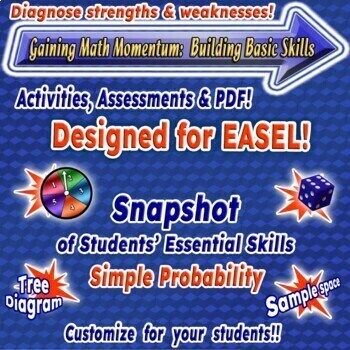PROBABILITY EASEL Activity & Assessment-Basic Skills Snapshot-Diagnostic Part 1
- PDF
- Easel Activity
- Easel Assessment
Description
Are your students STRUGGLING with the BASICS of PROBABILITY?
Are you trying to identify areas of weakness with these essential math skills?
Quickly assess each student’s understanding of critical probability concepts!!
Address those deficiencies using EASEL -- duplicate & revise the EASEL template to build those skills!
We have regrouped exercises from our popular math warm-ups to produce this Snapshot of Students’ Essential Skills in SIMPLE PROBABILITY using the capabilities of TpT’s EASEL!! This product focuses on the critical math concepts of SIMPLE PROBABILITY. You will be purchasing 10 problems (see description below), each offered as an EASEL Assessment and as an EASEL Activity. This provides you with the ability to fully customize each problem for your students or to generate similar additional problems focused on one specific math skill. The PDF document, which offers each exercise on its own individual page, also provides detailed, easy-to-understand solutions to each question.
These multiple choice problems can be used to quickly assess students’ math skills and understanding of specific concepts, providing you with the information needed to address areas of weakness and to reteach or reinforce essential skills (self-checking features provided by EASEL). These exercises can also be used to diagnose possible reasons for a student’s lack of progress in mathematics by exposing missing skills, fundamental math errors, or a lack of proficiency with the basics. This product could be used to evaluate students’ basic knowledge of simple probability in Grades 5 or 6 math, PreAlgebra, Algebra, or any high school math course.
This product includes the following types of problems:
Problem 1: Find the probability of a single event (number cube) with fraction and whole number answer choices.
Problem 2: Find the probability of an impossible event (number cube) with fraction and whole number answer choices.
Problem 3: Find the probability of a single event (lollipops) with fraction, decimal and percent answer choices.
Problem 4: Find the probability of a single event (spinner) with fraction and whole number answer choices.
Problem 5: Find the probability of a single event (number cube, complement) with fraction and whole number answer choices.
Problem 6: Find the number of outcomes in the sample space (tree diagram).
Problem 7: Find the probability using the sample space (tree diagram) with fraction and whole number answer choices.
Problem 8: Determine whether statements regarding basic concepts of probability are true or false.
Problem 9: Compare theoretical and experimental probabilities.
Problem 10: Word problem -- Find the probability of a single event (lottery tickets) with decimal, percent and whole number answer choices.
Key features of this Math Momentum Snapshot problem set:
- Each exercise is available in an EASEL Assessment, in an EASEL Activity, and as a single page in PDF format.
- All problems can be customized using the special EASEL capabilities provided by Teachers Pay Teachers.
- Problem pages can be assigned as a daily quiz with students’ scores available (scored by EASEL) or as a daily warm-up with instant insight into students’ understanding.
- Multiple choice answers are provided for each exercise based on the design of numerous standardized tests.
- Detailed step-by-step solutions are available for every question in the PDF version (methods shown reinforce development of basic mathematical processes).
- Common Core State Standards for Mathematics as well as most appropriate Mathematical Practice are noted for each problem on the PDF version (although more than one practice often applies).
We hope that you find this EASEL product beneficial and we look forward to your comments! We value your input! We encourage you to use these math problems to uncover your students’ areas of strength or weakness and build math proficiency in your classroom!
Follow Math Momentum on TpT and on Facebook!!
Rachel & Susan
Gaining Math Momentum
© 2022 Ripples-to-Waves Publications
All rights are reserved by the authors. Purchase of this product entitles only the original buyer to use this material in their classroom to serve their students. Reproducing for more than one teacher or classroom, or for an entire department or school district is prohibited. This product may not be distributed or displayed digitally for public view, uploaded to school or district websites, distributed via email, or submitted to file sharing sites. Failure to comply is a copyright infringement and a violation of the Digital Millennium Copyright Act (DMCA).






